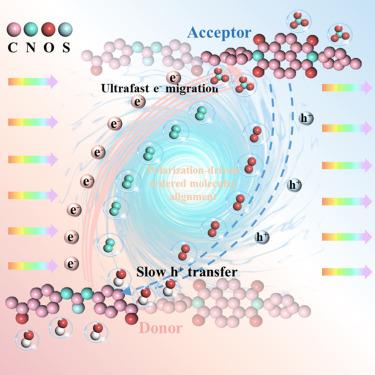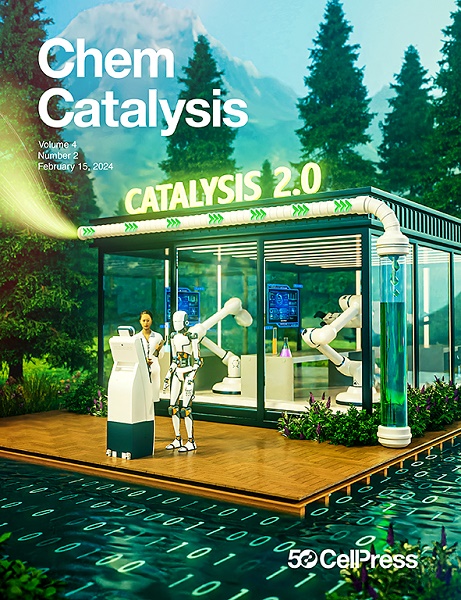双极性工程打破电荷转移动力学平衡,增强空气中h2o2介导的硝酸盐光合作用
IF 11.6
Q1 CHEMISTRY, PHYSICAL
引用次数: 0
摘要
由于空穴转移慢和电子迁移快,h2o2介导的空气光催化硝酸盐可持续合成面临载流子不平衡。我们通过将硫/氧双极性单元集成到缺电子型萘二亚胺(NDI)基供体-受体(D-A) π-框架中,实现了时空电子-空穴解耦。实验和理论分析表明,这种双极性结构产生了串联的内源电场和强大的宏观极化,创造了空间分离的“电子平台”和“空穴超级通道”,从而减少了重组并加速了氧化还原动力学。至关重要的是,极化诱导的有序分子排列使反应物取向对齐,并降低N≡N解离势垒,使氧还原和氮氧化同时发生。优化后的催化剂硝酸盐产率达到创纪录的8.89 mg g−1 h−1,表观量子效率为5.50%,优于最先进的无金属体系。我们的工作引入了创新的设计原则,并为实现对电子和空穴载流子转移速率的微分双向控制提供了深刻的视角。本文章由计算机程序翻译,如有差异,请以英文原文为准。

Dual-polarity engineering breaks charge transfer kinetic balances to enhance H2O2-mediated nitrate photosynthesis from air
Sustainable H2O2-mediated photocatalytic nitrate synthesis from air faces carrier imbalance due to slow hole transfer and ultrafast electron migration. We overcome this by integrating sulfur/oxygen dual-polarity units into electron-deficient naphthalene diimide (NDI)-based donor-acceptor (D-A) π-frameworks, achieving spatiotemporal electron-hole decoupling. Experimental and theoretical analyses indicate that this dual-polarity architecture gives rise to tandem endogenous electric fields and robust macroscopic polarization, creating spatially separated “electron platforms” and “hole superchannels,” which reduce recombination and accelerate redox kinetics. Crucially, polarization-induced ordered molecular alignment aligns reactant orientations and lowers N≡N dissociation barriers, enabling concurrent oxygen reduction and nitrogen oxidation. The optimized catalyst achieves a record nitrate yield of 8.89 mg g−1 h−1 with an apparent quantum efficiency of 5.50%, outperforming state-of-the-art metal-free systems. Our work introduces innovative design principles and offers a profound perspective for achieving differential bidirectional control over electron and hole carrier transfer rates.
求助全文
通过发布文献求助,成功后即可免费获取论文全文。
去求助
来源期刊
CiteScore
10.50
自引率
6.40%
发文量
0
期刊介绍:
Chem Catalysis is a monthly journal that publishes innovative research on fundamental and applied catalysis, providing a platform for researchers across chemistry, chemical engineering, and related fields. It serves as a premier resource for scientists and engineers in academia and industry, covering heterogeneous, homogeneous, and biocatalysis. Emphasizing transformative methods and technologies, the journal aims to advance understanding, introduce novel catalysts, and connect fundamental insights to real-world applications for societal benefit.

 求助内容:
求助内容: 应助结果提醒方式:
应助结果提醒方式:


